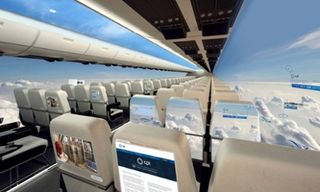Energy-saving windowless plane being developed
UK developers are working on an energy-saving plane with smartscreen panels instead of windows

The windows on commercial planes could be replaced with smartscreen panels within 10 years, a group of UK developers have promised, after early concepts for a windowless plane have surfaced.
The panels, situated on the back of seats and as the walls of the plane, can be turned on and off according to preference. They could be used by passengers for a range of activities such as viewing the outside sky, checking emails and browsing the internet during their journey, The Guardian reports.
Dr Jon Helliwell said: "You could have a display next to a seat if you wanted it; you could have a blank area next to a seat if you wanted it; you would have complete flexibility as to where you put [the panel screens]. You could put screens on the back of seats in the middle and link them to the same cameras."
The technology is being developed by the Centre for Process Innovation in north-east England, and its primary goal is to scale down the weight of commercial aircrafts and subsequently save energy.
The inclusion of windows on an aircraft requires walls to be further reinforced, so without them the plane would be far lighter.
"We had been speaking to people in aerospace and we understood that there was this need to take weight out of aircraft," Helliwell continued.
"Follow the logical thought through. Let's take all the windows out that's what they do in cargo aircraft what are the passengers going to do? If you think about it, it's only really the people that are sitting next to windows that will suffer."
Get the ITPro. daily newsletter
Receive our latest news, industry updates, featured resources and more. Sign up today to receive our FREE report on AI cyber crime & security - newly updated for 2024.
The concept would be possible with flexible organic light-emitting diodes (OLEDs), which eliminate the need to encase the lights in inflexible glass casings and make them suitable for use in aeroplanes. It is the same technology used in mobile phones and TVs.
Problems with cost and durability still stand in the way of making it a reality just yet, however.
"What would be great would be to make devices based on OLEDs that are flexible," Helliwell added.
"We can make transistors that are flexible but if we can make OLEDs that are flexible, that gives us a lot of potential in the market because we can print OLEDs on to packaging, we can create flexible displays."
Caroline has been writing about technology for more than a decade, switching between consumer smart home news and reviews and in-depth B2B industry coverage. In addition to her work for IT Pro and Cloud Pro, she has contributed to a number of titles including Expert Reviews, TechRadar, The Week and many more. She is currently the smart home editor across Future Publishing's homes titles.
You can get in touch with Caroline via email at caroline.preece@futurenet.com.





